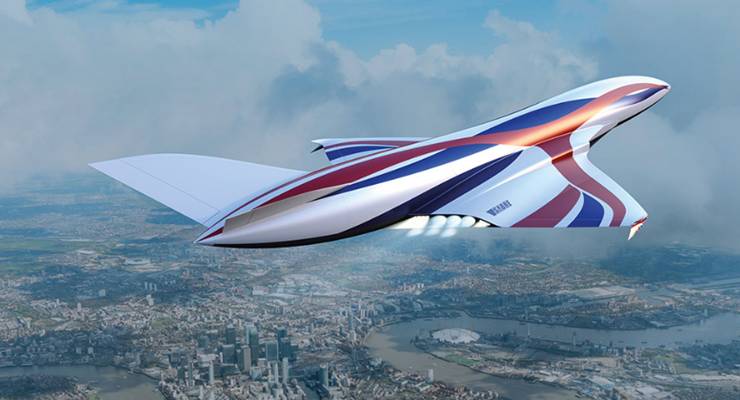
Betcha-by-golly-by-wowza, the future of tomorrow really is today. On Saturday, Sunrise reported that a “hypersonic space-plane that can transport passengers from Australia to the UK in four hours could be up and running in 10 years’ time”.
The jet, which is being developed by British firm Reaction Engines, would be powered by hydrogen and travel at five times the speed of sound (or 6000km per hour). Sunrise discussed it with Industry, Science and Technology Minister Karen Andrews, who said it was “absolutely possible that we will be able to fly from Australia to London in four hours”.
All of this is, obviously, incredible. And it was equally incredible roughly two weeks ago, when it was reported by news.com.au, Vice and The Sun. Or in March this year, when BBC reported on the Sabre hypersonic engine being ready to enter “a key testing phase”. At that stage, we were still reeling from the news, in June 2018, that Boeing had “unveiled a new hypersonic 6400km per hour jet that could fly from New York to London in just two hours and from Australia to Europe in less than five”.
Personally, I didn’t think I had any excitement left after the Australian Financial Review’s March 2018 report on the The University of Queensland’s Centre for Hypersonics SPARTAN project, which could give us commercial flights from Sydney to London in just two hours.
The last time travel news had gotten us that excited would have to be in May 2016, when it was reported that a two-hour Sydney to London flight was on track for a 2018 launch. This, coming a mere six months after we heard getting from Sydney to London in four hours had gotten another step closer. And look… that one was hard to get too excited about, given the fact that in 2011 we were being promised a hypersonic plane could fly Sydney to London in 49 minutes.
We here in the Crikey bunker have nothing but sympathy for journos desperately trying to fill the slate with fun technology stories over a long weekend, but maybe we should wait until something actually, you know, happens?








These articles on hypersonic space planes go back much earlier than Charlie Lewis reports. Back in the mid-1980s I recall reading about the Horizontal Take-Off And Landing (HOTOL) spaceflight project reported from the UK that would take passengers on sub-orbital flights from Sydney to London in around ninety minutes. The proposed vehicle looked a bit like an extended version of the Space Shuttle. HOTOL would be propelled at supersonic speeds by supersonic combustion ramjet (Scramjet) engines which were reportedly under development at the time. I was looking forward eagerly to taking one of these passenger flights (both for the views of Earth and the weightlessness experience) and have kept my eyes out for news of progress, but not surprisingly HOTOL hasn’t got off the ground yet, certainly on a commercial basis.
Don’t forget the Boeing SST, the US’ face saving response to Concorde costing taxpayers billions and finally dumped early 70’s.
Also conveniently ignored is why Concorde only ever flew across the sea which is sonic booms. I had a sonic boom go off directly over me once from an Indian military plane. Boom is a vast understatement. There was also the matter of the extreme fuel consumption. Even the noise at low level and speed was extraordinary. Concorde did a promo flight to Melb and it could be heard across the city as it took off.
Maybe these hyper planes would be too high for sonic booms and so on. If something sounds too ridiculous to be true…. maybe employ writers with technical ability for the job.
I don’t know why anyone would want to travel at a piddling 6000 km an hour. We’re currently moving at 828,000 km an hour around the galactic centre. At that speed, one would be able to circumnavigate the Earth in a little less than 3 minutes.
Anyway. At that speed, if anything major goes wrong with the plane, the chances of surviving would go from Buckley’s to less than Buckley’s.
Yep. In fact it goes back waaaay further than that. Decades in fact. I can remember stories like this regularly popping up, every couple of years, since at least the late 80’s.
And as someone pointed out, as soon as they make an engine that can propel a vehicle that fast, it’s going to be used to power a missile before it’s going to be used to power a passenger plane.
Personally, I’ll believe it when I can buy a ticket for a flight on said plane.
An aircraft fast enough to travel clean around the equator in 1.4 hours would have a centrifugal force equal to its weight. This is convenient, as the aircraft no longer needs lift. If it is flying high enough, it is not suffering drag either, saving on fuel. By flying upside down, any passengers would have a grand view of Earth, seemingly above them. However the downsides of weightlessness and the impact of re-entry would add to the unavoidable inconveniences of jetlag and sonic boom. It is more likely that unmanned hypersonic vehicles will provide an air-breathing first stage for launching satellites.
Well, a plane capable of flying around the Earth in 1.4 hours would be moving at around 25,000 km per hour, which is 4 times more than the purported hypersonic plane.
It would also be in orbit, so it’s a spacecraft not a plane, with all the costs of space travel.
It wouldn’t be saving fuel. It actually would be using considerably more.
I remember it broke my fathers heart when the Concord was banned from flying across land. He knew it was the death knell. He was involved with its development in the 60s and as an old school scientist/ engineer he could only see it as a marvel of technology, never the down sides. He predicted that as sonic boom was the problem, the only solution was Sydney to London, straight up to the upper atmosphere and down to London, approx one hour. Indeed more or less what is on one of Boeing’s drawing boards. I doubt I’ll see it in my lifetime, but it will happen.